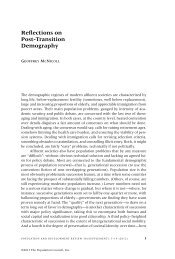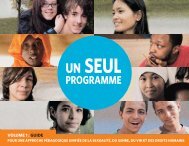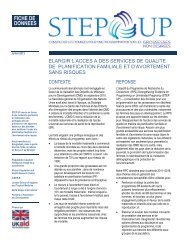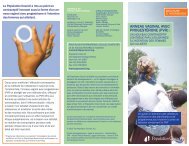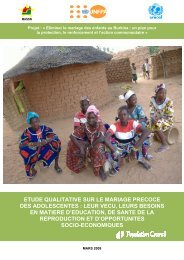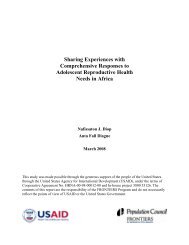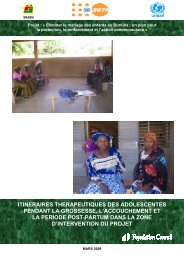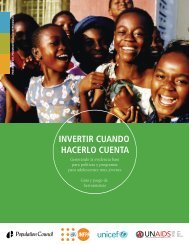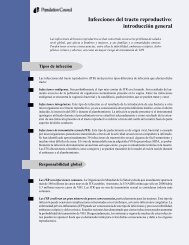Community Health Volunteer's Training Manual - Population Council
Community Health Volunteer's Training Manual - Population Council
Community Health Volunteer's Training Manual - Population Council
Create successful ePaper yourself
Turn your PDF publications into a flip-book with our unique Google optimized e-Paper software.
<strong>Community</strong> Mobilisation and Participation<br />
CHVs/VHCs need to determine what their community members’ attitudes are towards<br />
the problem or issue and what the public expects. If there is high interest they are likely to<br />
support the activities to solve the problem. Find out this during the planning stage so that<br />
you can put in strategies to sustain community interest. Box 2.3.4 lists some key steps in<br />
planning.<br />
Box 2.3.4 Some of the things you do in planning<br />
Analyse<br />
The ability to analyse issues and information is necessary for effective mobilisation. After the<br />
analysis you have to choose a course of action. Since each course of action has advantages and<br />
disadvantages, you have to carefully weigh all the alternative actions before you make the decision.<br />
Also you need to find out peoples’ perceptions about the issues and their willingness to participate<br />
in any activity you plan to do. For example: helping a community to decide on which project to work<br />
on malaria prevention or family planning programme.<br />
Set Objectives and targets<br />
Set objectives and targets that are clear, simple, and can be measured. For example, if the<br />
community selects the Malaria prevention programme then they can set objectives and targets like:-<br />
“To distribute ITNs to 70% of pregnant women and 80% of children under five years in Tobo district,<br />
by December 2008”.<br />
Planning<br />
The ability to draw effective and workable plans is a skill that can be learnt by doing. Provide<br />
communities with adequate information on the effects of the problem/issue you are trying to<br />
address. The plan you put together should answer the ‘5Ws’ and ‘H’ that is:<br />
• What do you want to do? E.g. Prevent malaria among pregnant women and children under 5<br />
years through the distribution of ITNs.<br />
• Why do you want to do it? E.g. To reduce the deaths from malaria in children under five and<br />
pregnant women.<br />
• Who will carry out the different activities? E.g. Volunteers will distribute ITNs to pregnant women<br />
and children under five in the community.<br />
• When should the activity be done? E.g. Distribution of the ITNs will start in January 2007 and<br />
end in December 2008.<br />
• Which resources will be needed and who will provide them? E.g. Volunteers will need bicycles,<br />
home-visiting bags, ITNs and record keeping forms. Donors will supply ITN and bicycles;<br />
DHMTs will supply home visiting bags; and Ghana <strong>Health</strong> Service will provide record keeping<br />
forms.<br />
• How will the activities be carried out?’ E.g. The ITNs will be distributed at the CHC, at homes, at<br />
durbar grounds, and other community distribution outlets.<br />
Managing/Organising<br />
All community volunteers must have organisational and management skills because<br />
community groups have to be organised, executive committees formed and strengthened.<br />
This skill comes by practice just like all the technical skills we have discussed in this session.<br />
For example, if your community plans to hold a durbar to create awareness on the use of<br />
ITNs, you have to work with the CHO to organise the community members and invited<br />
121



